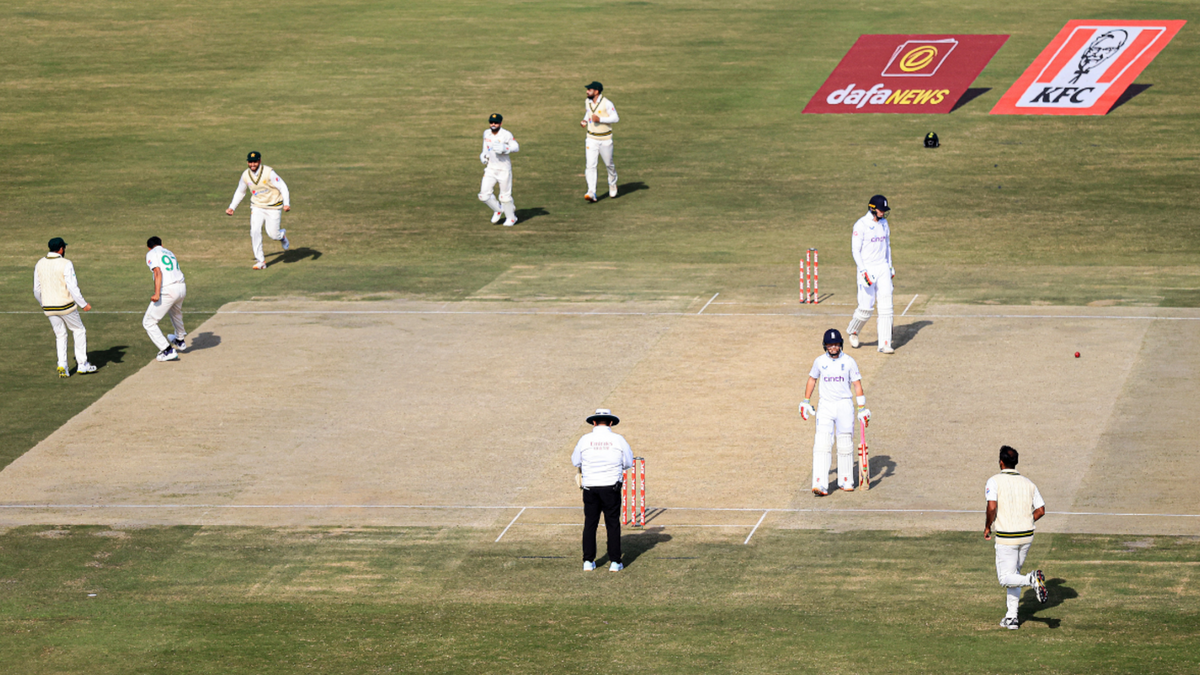
The Rawalpindi pitch used for the first Pakistan-England Test has escaped a ‘poor’ rating, getting a ‘below average’ mark from the ICC despite the Test breaking all manner of records for the number of runs scored in the game.
Though a result was reached in the game earlier this month, there was little on offer for the bowlers. England made 657 in their first innings, including over 500 in a shortened opening day, and in reply, Pakistan notched up 579. Ben Stokes’ team decided to go for the kill with a bold declaration in their second dig, finishing their innings at 264-7 declared in 35.5 overs, going at over run a ball in both their innings – a first in Test cricket. Set a target of 343 for a win, Pakistan were well on course to chase the target down before Ollie Robinson and James Anderson picked up four wickets each, to help England to a 1-0 lead.
Overall, 1,768 runs were scored by both teams for the fall of 37 wickets during the game – the most ever in a five-day Test – and the lack of a fair contest was criticised in the media and closer to home, with Pakistan Cricket Board chairman Ramiz Raja also terming the pitch “embarrassing”. Speaking to the media, he said, “It is embarrassing for us, especially when you have a cricketer as chairman. This is not a good advert for cricket. We’re a better cricketing nation than this.
“We live in the dark ages of pitches in Pakistan. They aren’t exposed in T20 and 50 overs but they are in Test cricket. We lived in an apartheid situation where teams didn’t come here. Pakistan players had played 70 Tests without playing here. It’s an achievement that we managed to stay afloat. We’ve tried everything, bringing in a curator from abroad. Pitches are the lifeblood of cricket in a country.”
ICC match referee Andy Pycroft, who officiated the first Test, handed a ‘below average’ rating to the track, including a demerit point.
“It was a very flat pitch which gave almost no assistance to any type of bowler,” Pycroft said. “That was the main reason why batters scored very fast and both sides posted huge totals. The pitch hardly deteriorated during the course of the match. Since there was very little in it for the bowlers, I found the pitch to be ‘below average’ as per the ICC guidelines.”
According to the ICC’s Pitch and Outfield Monitoring Process, which is in use since January 2018, “the objective of a Test pitch shall be to allow all the individual skills of the game to be demonstrated by the players at various stages of the match. If anything, the balance of the contest between bat and ball in a Test match should slightly favour the bowling team” and “a pitch should be expected to deteriorate as the match progresses, and as a consequence, the bounce could become more inconsistent, and the ball could deviate more (seam and spin) off the wearing surface”.
A pitch can be rated poor in the following scenarios:
- The pitch offers excessive seam movement at any stage of the match
- The pitch displays excessive unevenness of bounce for any bowler at any stage of the match
- The pitch offers excessive assistance to spin bowlers, especially early in the match
- The pitch displays little or no seam movement or turn at any stage in the match together with no significant bounce or carry, thereby depriving the bowlers of a fair contest between bat and ball
- The pitch displays excessive moisture making its playing characteristics unpredictable, or excessive dryness leading to the surface to deteriorate.
Rawalpindi has now received a demerit point in each of its last two Tests, with the track that was used for the Pakistan-Australia wicket at the start of the year also being given a ‘below average’ rating. A ‘below average’ rating gets a venue one demerit point, while a ‘poor rating’ fetches three demerit points.
If a venue accumulates a total of five demerit points in a rolling five-year period, it will be banned from hosting international cricket for a period of 12 months.








